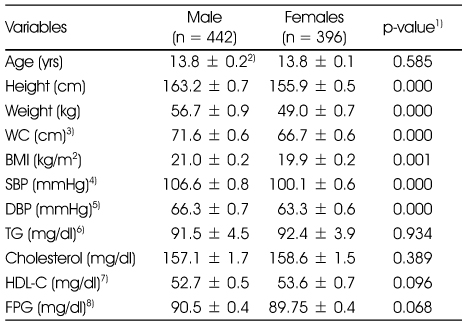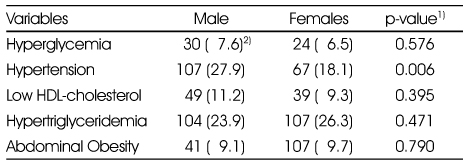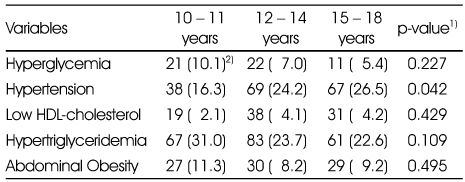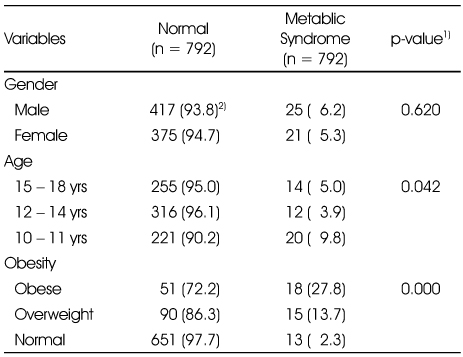Articles
- Page Path
- HOME > Korean J Community Nutr > Volume 19(2); 2014 > Article
-
Research Article
- Prevalence of Metabolic Syndrome and Metabolic Abnormalities in Korea Children and Adolescents and Nutrient intakes: Using 2008 the Korea National Health and Nutrition Examination Survey
- Hang-Me Nam, Mi-Ja Choi
-
Korean Journal of Community Nutrition 2014;19(2):133-141.
DOI: https://doi.org/10.5720/kjcn.2014.19.2.133
Published online: April 30, 2014
Department of Food and Nutrition, Keimyung University, Daegu, Korea.
- Corresponding author: Mi-Ja Choi. Department of Food and Nutrition, Keimyung University, 1000 Sindang-dong, Dalseo-gu, Daegu, Korea. Tel: (053) 580-5874, Fax: (053) 580-5885, choimj@kmu.ac.kr
Copyright © 2014 The Korean Society of Community Nutrition
This is an Open-Access article distributed under the terms of the Creative Commons Attribution Non-Commercial License (http://creativecommons.org/licenses/by-nc/3.0/) which permits unrestricted non-commercial use, distribution, and reproduction in any medium, provided the original work is properly cited.
- 161 Views
- 3 Download
- 6 Crossref
Abstract
-
Objectives
- The purpose of this study was to estimate the prevalence of metabolic syndrome (MS), metabolic abnormalities, and nutrient intakes in Korea children and adolescents using the Korea National Health and Nutrition Examination Survey from 2008.
-
Methods
- A sample of 838 children and adolescent males (n = 442) and females (n = 396) aged 10-18 was used from the 2008 Korea National Health and Nutrition Examination survey. The diagnosis of the metabolic syndrome subjects was adapted from modified National Cholesterol Education Program-Adult Treatment Panel III by Ford. To compare nutrient intakes, we used a judgment sampling. The first group was composed of all children and adolescents (n = 46) with MS. The second one along with the first group had children and adolescents with the same age, sex, and body mass index (BMI) but without MS (n = 46). The control group like the first two had children and adolescents with same sex and same age but with normal BMI and without MS (n = 46).
-
Results
- In this randomized controlled controlled trial, the prevalence of the metabolic syndrome was 5.8%. The risk factors was associated with the MS were abdominal obesity 9.4%, hypertriglyceridemia 25.0%, low HDL-cholesterol 10.3%, hypertension 23.4%, and hyperglycemia 7.1%. Among metabolic abnormalities, blood pressure was significantly affected by sex, age and obesity. On the other hand, HDL-cholesterol, triglycerides, and waist circumference were directly linked to obesity. There were no significant differences in nutrient intakes among the three groups.
-
Conclusions
- The prevalence of MS was higher in children (10-11 years old) than in adolescents (12-18 years old). There was a difference in hypertension among risk factors by gender, and there were no significant differences in nutrient intakes.
- 1. Ambrosini GL, Huang RC, Mori TA, Hands BP, O'Sullivan TA, Klerk NH, Beilin LJ, Oddy WH. Dietary patterns and markers for the metabolic syndrome in Australian adolescents. Nutr Metab Cardiovasc Dis 2010; 20(4): 274-283.ArticlePubMed
- 2. Casazza K, Dulin-Keita A, Gower BA, Fernandez JR. Differential influence of diet and physical activity on components of metabolic syndrome in a multiethnic sample of children. J Am Diet Assoc 2009; 109(2): 236-244.ArticlePubMedPMC
- 3. Chang JH, Kim DH, Kim HS, Choi IK, Cheong MY, Kin DK. Prevalence of metabolic syndrome in obese children. Korean J Pediatr 2004; 47(11): 1149-1156.
- 4. Chen W, Xu J, Srinivasan SR, Berenson GS, Li S. Metabolic syndrome variables at low levels in childhood are beneficially associated with adulthood cardiovascular risk. Diabetes Care 2005; 28(1): 126-131.ArticlePubMedPDF
- 5. Cho YG, Song HG, Kang JH. Prevalence of the metabolic syndrome in Korean children and adolescents according to the international diabetes federation definition in children and adolescents. Korean J Fam Med 2009; 30(4): 261-268.Article
- 6. Choi MK, Jun YS, Bae YJ, Sung CJ. A study on nutrient intakes and blood parameters of adult men and women with metabolic syndrome. J Korean Soc Food Sci Nutr 2007; 36(3): 311-317.Article
- 7. Cook S, Weitzman M, Auinger P, Nguyen M, Dietsz WH. Prevalence of a metabolic syndrome phenotype in adolescents findings from the third national health and nutrition examination survey, 1988-1994. Arch Pediatr Adolesc Med 2003; 157(8): 821-827.ArticlePubMed
- 8. de Ferranti SD, Gauvreau K, Ludwig DS, Niufeld EJ, Jane W. Prevalence of the metabolic syndrome in American adolescents: findings from the third national health and nutrition examination survey. Circulation 2004; 110(16): 2494-2497.ArticlePubMed
- 9. Ford ES, Ajani UA, Mokdad AH. The metabolic syndrome and concentrations of C-reactive protein among U.S. youth. Diabetes Care 2005; 28(4): 878-881.ArticlePubMedPDF
- 10. Ford ES, Giles WH, Mokdad AH. Increasing prevalence of the metabolic syndrome among U.S. adults. Diabetes Care 2004; 27(10): 2444-2449.ArticlePubMedPDF
- 11. Grundy SM, Brewer HB Jr, Cleeman JI, Smith SC Jr, Lenfant C. Definition of metabolic syndrome: report of the National Heart, Lung, and Blood institute/American Heart Association conference on scientific issues related to definition. Circulation 2004; 109: 433-438.ArticlePubMed
- 12. Huh K. Metabolic syndrome in Korean children and adolescents; from the Korean NHANES 1998~2007 data analysis. Inje University; 2009; MS thesis.
- 13. Isomaa B, Almgren P, Tuomi T, Forwen B, Lahti K, Nissen M, Taskinen MR, Groop L. Cardiovascular morbidity and mortality associated with the Metabolic syndrome. Diabetes Care 2001; 24(4): 683-689.ArticlePubMedPDF
- 14. Dallongeville J, Jean BR, Dominique C, Bernadette H, Jean F, Pierre D, Dominique A, Philippe A, Annie B. Household income is associated with the risk of metabolic syndrome on a sex-specific manner. Diabetes Care 2005; 28(2): 409-415.PubMed
- 15. Jung JH. Associations between metabolic syndrome and nutrient intake and health-related risk factors. Sungshin Women's University; 2009; MS thesis.
- 16. Kim DI, Kim JY, Lee MK, Lee HD, Lee JW, Jeon JY. The relationship between fitness, BMI and risk factors of metabolic syndrome among university students in Korea. Korean J Obes 2012; 21(2): 99-107.Article
- 17. Kong KA. Prevalence and risk factors of metabolic syndrome in young schoolchildren. Seoul: Ewha Womans University; 2008; Dissertation.
- 18. Korea Centers for Desease Control and Prevention. Report on 2008 national health and nutrition survey. 2009.
- 19. Kwon HS, Park YM, Lee HJ, See JH, Choi YH, Ko SH, Lee JM, Kim SR, Kang SY, Lee WC, Ahn MS, Noh JH, Kang JM, Kim DS, Yoon KH, Chal BY, Lee DW, Kang SK, Son HY. The prevalence and clinical characteristics of the metabolic syndrome in middle-aged Korean adult. Korean J Med 2005; 68(4): 359-368.
- 20. Kwon SY. The study of association between metabolic syndrome and dietary factors among mothers and their children based on the data from 2007-2010 KNHANES. Catholic University; 2014; MS thesis.
- 21. Lee CG, Moon JS, Choi JM, Nam CM, Lee SY, Oh KW, Kim YT. Normative blood pressure references for Korean children and adolescents. Korean J Pediatr 2008; 51(1): 33-41.Article
- 22. Lee MS, Sung CJ, Sung MK, Choi MK, Lee YS, Cho KO. A comparative study on food habits and nutrient intakes among high school students with different obesity indexes residing in seoul and Kyunggi-do. Korean J Community Nutr 2000; 5(2): 141-151.
- 23. Lim HS, Kim SK. Comparative of the nutritional status and correlation of cardiovascular disease in type II diabetes mellitus patients with metabolic syndromes. Korean J Nutr 2008; 41(4): 327-340.
- 24. Lim S, Jang HC, Park KS, Lee HK, Chung HR, Joung HJ, Cho SI. Changes in metabolic syndrome of Korean children and adolescents in the period 1998 to 2001. J Endocrinol Invest 2008; 31(4): 327-333.ArticlePubMedPDF
- 25. Lim S, Lee HK, Park KS, Cho SI. Changes in the characteristics of metabolic syndrome in Korea over the period 1998-2001 as determined the Korean national health and nutrition examination surveys. Diabetes Care 2005; 28(7): 1810-1812.PubMed
- 26. Moon JS, Lee SY, Nam CM, Choi JM, Choi BK, Seo JW, Oh KW. 2007 Korean National Growth Charts : Review of developmental process and outlook. Korean J Pediatr 2008; 51(1): 1-25.Article
- 27. Morrison JA, Friedaman SA, Wang P, Glueck CJ. Metabolic syndrome in childhood predicts adult metabolic syndrome and type 2 diabetes mellitus 25 to 30 years later. J Pediatr 2008; 152(2): 201-206.ArticlePubMed
- 28. Park JS, Park ES. Prevalence of metabolic syndrome and nutrient intakes of obese middle school students in Korea - Focused on Namwon city, Jeonbuk. J Korean Living Sci Assoc 2008; 17(1): 159-170.Article
- 29. Park MJ, Yun KE, Lee GE, Cho HJ, Park HS. The relationship between socioeconomic status and metabolic syndrome among Korean adults. Korean J Obes 2006; 15(1): 10-17.
- 30. Reaven GM. Role of insulin resestance in human disease. Diabetes 1988; 37: 1595-1607.Article
- 31. Roh DJ. Prevalence of insulin resistance and metabolic syndrome and effects of health promotion program among obese children in Jeju. Jeju National University; 2012; Dissertation.
- 32. Wamala SP, Murray AM, John L, Karin SG, Myriam H, Kristina OG. Education and the metabolic syndrome in women. Diabetes Care 1999; 22(12): 1999-2003.ArticlePDF
- 33. Seo MJ, Seong JW, Sohn KJ, Ko BJ, Han JH, Kim SM. Prevalence of the metabolic syndrome in Korean children and adolescents. J Korean Acad Fam Med 2006; 27(10): 798-806.
- 34. Seo SJ. A study on the prevalence and the risk factors of metabolic syndrome in Korean children and adolescents. Seoul National University; 2006; MS thesis.
- 35. The Korean Nutrition Society. Dietary Reference Intakes for Korean, Seoul. 2005.
- 36. Weinberger MH, Finegerg NS. Sodium and volume sensitivity of blood pressure: age and pressure change over time. Hypertension 1991; 18: 67-71.ArticlePubMed
- 37. Yoo HJ, Kim YH. A study on the characteristics of nutrient intake in metabolic syndrome subjects. Korean J Nutr 2008; 41(6): 510-517.
- 38. Yoon YS. Trends of prevalence and associated factors of metabolic syndrome in Korean children and adolescents -Using the Korea national health and nutrition examination survey. Ulsan University; 2008; Dissertation.
REFERENCES

1) Group 1: This group is composed of children and adolescents (46) with Metabolic Syndrome
2) Group 2: This group has been configured identically to Group 1 in age, sex, and body mass index (BMI) but without Metabolic Syndrome
3) Group 3: This group has been configured identically to Group 1 in sex and age but with normal body mass index (BMI) and without Metabolic Syndrome
4) p-values by one-way ANOVA
5) Mean ± SD
Figure & Data
REFERENCES
Citations

- Prevalence Trends of Metabolic Syndrome among Korean Children and Adolescents from a Population-Based Cross-Sectional Survey
Ji Hyun Kim, Jung Sub Lim
Life.2022; 12(9): 1404. CrossRef - Biochemical Index, Nutrition Label Use, and Weight Control Behavior in Female Adolescents: Using the 2010 and 2011 Korea National Health and Nutrition Examination Survey
Mi-Ja Choi, Hyun-Ju Jo, Mi-Kyung Kim
Clinical Nutrition Research.2020; 9(1): 32. CrossRef - Socioeconomic and Behavioral Characteristics Associated With Metabolic Syndrome Among Overweight/Obese School-age Children
Ok Kyung Ham
Journal of Cardiovascular Nursing.2017; 32(1): 30. CrossRef - Prevalence of Metabolic Syndrome among Korean Adolescents According to the National Cholesterol Education Program, Adult Treatment Panel III and International Diabetes Federation
Seonho Kim, Wi-Young So
Nutrients.2016; 8(10): 588. CrossRef - Dietary Assessment and Factors Related to Prevalence of Metabolic Syndrome in Korean Youth: Based on the Korea National Health and Nutrition Examination Survey 2007~2013
Yong-Suk Kwon, Yangsuk Kim, Eun-Mi Ahn, Hyun Ju Kang, Young-Hee Park, Young Kim
The Korean Journal of Community Living Science.2016; 27(4): 875. CrossRef - Evaluation of nutrient intake and food variety by age in Korean adolescents: Based on 2010~2012 Korean National Health and Nutrition Examination Survey
Yun-Jung Bae
Journal of Nutrition and Health.2015; 48(3): 236. CrossRef
- We recommend
- Related articles
-
- Total sugar intake and its contributed foods by age groups in Koreans using the 8th (2019–2021) Korea National Health and Nutrition Examination Survey: a cross-sectional study
- Comparative study on the health and dietary habits of Korean male and female adults before and after the coronavirus disease 2019 pandemic: utilizing data from the 8 th Korea National Health and Nutrition Examination Survey (2019–2021)
- Development of Korean NOVA Food Classification and Estimation of Ultra-Processed Food Intake Among Adults: Using 2018 Korea National Health and Nutrition Examination Survey
- Trends in Dietary Protein Intake and Its Adequacy among Korean Adults: Data from the 2010 ~ 2019 Korea National Health and Nutrition Examination Survey (KNHANES)
- Assessment of Nutrient Intake and Dietary Quality of Korean Adults in Metabolic Syndrome Patients According to Taking Medical Care: Based on the 2017 Korea National Health and Nutrition Examination Survey
Modified NCEP/ATP III Definition of Metabolic Syndrome for Children and Adolescents
1) WC: Waist circumference
2) HDL-cholesterol: High density lipoprotein cholesterol
Age, anthropometric measurements, and biochemical indices of the subjects
1) p-value by t-test
2) Mean ± SD
3) WC: Waist circumference, 4) SBP: Systolic blood pressure, 5) DBP: Diastolic blood pressure, 6) TG: Triglycerides, 7) HDL-C: High density lipoprotein cholesterol, 8) FPG: Fasting plasma glucose
Prevalence of individual metabolic abnormalities by gender
1) p-value by χ2-test
2) Unweighted frequency (Estimated %)
Prevalence of individual metabolic abnormalities by age
1) p-value by χ2-test
2) Unweighted frequency (Estimated %)
Prevalence of individual metabolic abnormalities by obesity
1) Normal: 5 - 85th percentiles of BMI for age in Korean growth chart
2) Overweight: 85 - 95th percentiles of BMI for age in Korean growth chart
3) Obesity: above the 95th percentiles of BMI for age in Korean growth chart or BMI ≥ 25 kg/m2
4) p-value by χ2-test
5) Unweighted frequency (Estimated %)
Prevalence of metabolic syndrome
1) p-value by χ2-test
2) Unweighted frequency (Estimated %)
The mean energy and nutrient intake by groups
1) Group 1: This group is composed of children and adolescents (46) with Metabolic Syndrome
2) Group 2: This group has been configured identically to Group 1 in age, sex, and body mass index (BMI) but without Metabolic Syndrome
3) Group 3: This group has been configured identically to Group 1 in sex and age but with normal body mass index (BMI) and without Metabolic Syndrome
4) p-values by one-way ANOVA
5) Mean ± SD
1) WC: Waist circumference 2) HDL-cholesterol: High density lipoprotein cholesterol
1) p-value by t-test 2) Mean ± SD 3) WC: Waist circumference, 4) SBP: Systolic blood pressure, 5) DBP: Diastolic blood pressure, 6) TG: Triglycerides, 7) HDL-C: High density lipoprotein cholesterol, 8) FPG: Fasting plasma glucose
1) p-value by χ2-test 2) Unweighted frequency (Estimated %)
1) p-value by χ2-test 2) Unweighted frequency (Estimated %)
1) Normal: 5 - 85th percentiles of BMI for age in Korean growth chart 2) Overweight: 85 - 95th percentiles of BMI for age in Korean growth chart 3) Obesity: above the 95th percentiles of BMI for age in Korean growth chart or BMI ≥ 25 kg/m2 4) p-value by χ2-test 5) Unweighted frequency (Estimated %)
1) p-value by χ2-test 2) Unweighted frequency (Estimated %)
1) Group 1: This group is composed of children and adolescents (46) with Metabolic Syndrome 2) Group 2: This group has been configured identically to Group 1 in age, sex, and body mass index (BMI) but without Metabolic Syndrome 3) Group 3: This group has been configured identically to Group 1 in sex and age but with normal body mass index (BMI) and without Metabolic Syndrome 4) p-values by one-way ANOVA 5) Mean ± SD

 KSCN
KSCN






 PubReader
PubReader Cite
Cite


